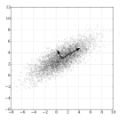In our "big data" age, the size and complexity of data is steadily increasing. Methods for dimension reduction are ever more popular and useful. Two distinct types of dimension reduction are "data-oblivious" methods such as random projections and sketching, and "data-aware" methods such as principal component analysis (PCA). Both have their strengths, such as speed for random projections, and data-adaptivity for PCA. In this work, we study how to combine them to get the best of both. We study "sketch and solve" methods that take a random projection (or sketch) first, and compute PCA after. We compute the performance of several popular sketching methods (random iid projections, random sampling, subsampled Hadamard transform, count sketch, etc) in a general "signal-plus-noise" (or spiked) data model. Compared to well-known works, our results (1) give asymptotically exact results, and (2) apply when the signal components are only slightly above the noise, but the projection dimension is non-negligible. We also study stronger signals allowing more general covariance structures. We find that (a) signal strength decreases under projection in a delicate way depending on the structure of the data and the sketching method, (b) orthogonal projections are more accurate, (c) randomization does not hurt too much, due to concentration of measure, (d) count sketch can be improved by a normalization method. Our results have implications for statistical learning and data analysis. We also illustrate that the results are highly accurate in simulations and in analyzing empirical data.
翻译:在我们的“ 大数据” 时代, 数据的规模和复杂性正在稳步增加。 降低维度的方法越来越受欢迎和有用。 降低维度的方法有两种不同类型。 降低维度的方法有“ 数据可见” 方法, 例如随机预测和草图, 和“ 数据认知” 方法, 如主元分析( PCA ) 。 两者都有其优点, 例如随机预测的速度, 和数据适应性。 在这项工作中, 我们研究如何将两者结合起来, 以获得最佳的两种方法。 我们研究“ 伸缩和解决” 方法, 首先随机预测( 或素描), 然后再计算 。 我们计算一些流行的快速绘图方法的性能( 随机 iid 预测、 随机抽样、 亚哈达玛德 变换版、 计数草图等), 以及“ 数据模型” 。 与众所周知的作品相比, 我们研究的结果 (1) 给出了“ 精确的准确性结果 ”, 当信号组件仅略度略度略高于噪音, 但预测是不可忽略的。 我们还研究了一些信号信号 。 ( 在精确的模型中, 我们的预测中, 我们的精确度结构下, 我们的精确度分析中发现, 我们的精确度结构中, 我们的精确度分析是 。


